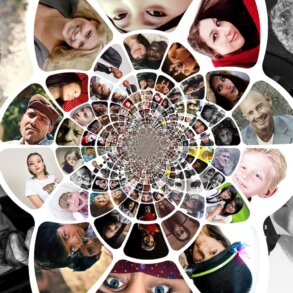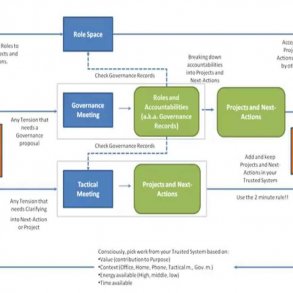By Natasha Miller Naderi and originally published on emerge-global.co
Fit Your Self-Management Style to Your Strategy

Increasingly, intelligent and high-conscious people and organizations from across the globe are drawn the world of Teal and self-management.
Through self-management, organizations are better equipped to capture collective intelligence, increase agility, and enhance innovation. We can treat our employees like adults, better engage everyone, improve just and respectful relationships, and so much more. Who wouldn’t want all that?
The challenge sets in, after we are sold on the dream. There are a multitude of models and practices working well in very different kinds of organizations.
I often hear consultants say, “pick any Teal practice and start implementing one at a time.” “Experiment with anything and see where it goes!”
I’ve also observed a tendency to gravitate to one very specific model of self-management, such as Holacracy, Haier’s Renandheyi model, Morning Star’s approach, etc., and assume it can apply to any organization.
When that happens, we are missing something VERY important! Organizations that successfully implement self-management, link their approach to a strategic understanding of how they create value.
The most successful models of self-management have aligned their strategic system (how they create superior market value), with their organization system (how they organize to deliver that value), and their people system (how to optimize the potential of people).

While it is absolutely true that the underlying principles behind them all are the same and can apply to any organization, the structures around how work and people are organized differ tremendously, depending on the strategy of the organization. (Read more about the fundamental principles underlying these organizations here: https://emerge-global.co/blog/f/unlocking-powerful-principles-of-emerging-organizations)
Implementing a self-management approach that doesn’t fit your strategy, can create a great deal of waste and frustration! Let’s look at how we can more strategically and systematically design a self-management system that fits your organization.
First, let’s look at a few examples to see how these systems are linked together.
Example #1: Morning Star
Strategic System
Morning Star is a tomato processing company with roughly 600 employees, which holds the overwhelming majority of market share of tomato processing and transport in the US.
Greatest value for this low-margin commodity business comes from efficiency, continuous improvement, and optimized flow of one continuous process of turning tomatoes into paste.
Organization System
At Morning Star, there are essentially two organizational layers. All are “colleagues” and there is one CEO.

A peer-to-peer network of commitments, created through Colleague Letters of Understanding (CLOUs) defines granular roles, commitments, indicators and levels of authority. These are set by the individuals themselves and agreed by those who depend and/or collaborate with their roles.
This organization system primarily grants authority to individuals, as opposed to teams.
People System
Within their strategic context, placing the greatest emphasis on keeping commitments is key, so that the process flows like clockwork through the season-dependent production system.
Two rules govern human interactions at Morning Star: 1) Keep your commitments (commitments are sacred!) and 2) No one person can use force against another person.
A platform supports individuals in managing their commitments, achieving their goals, and collaborating with others throughout the organization.
Example #2: Oticon
Strategic System

Oticon is a hearing aid technology company, based in Denmark with over 3,000 employees world-wide. This company outsmarted billion-dollar competitors including Siemens, Philips, Sony, 3M, and AT&T, to become the world’s leading manufacturer of hearing aids through their ‘spaghetti organization’.
Their strategy has been to out-innovate and respond faster than anyone else in the market through maximum flexibility and responsiveness.
As such, they reduced the time-to-market (product development cycle) by 50% and in launched the world’s first internet-connected hearing aid, called the Oticon Opn in 2016
Organization System
With a strategy to optimize innovation and flexibility, Oticon is purposefully designed as a disorganized, entrepreneurial, volunteer project-based company.
Internally there are no job titles or static job descriptions which eliminates categorization of employees and maximizes development opportunities. Similar to Morning Star, there is no middle management and no formal hierarchical reporting relationships.
People System
In order to maximize innovation and flexibility within this project-based company, anyone who comes up with a good idea is free to assemble a team and act as project leader of any new initiative at any time. Each project, then has to compete with all the other projects trying to get off the ground at any time. Individuals invited to join a project can decline.
Each employee selects their own mentor who conducts annual reviews and guidance sessions in order to support employee learning and development.
Professional development at Oticon is not rewarded with promotion, but with salary and ability to join or form project teams that have the biggest impact on the future of Oticon.
Example #3: Haier
Strategic System
Haier is a global appliance innovation center based in Qingdao, China, with close to 100,000 employees and about $40 billion in revenue. The core strategy of Haier is to drive innovation and zero-distance to the customer. Any kind of distance from the customer frustrates the achievement of customer satisfaction.
Organization System
With the aim to capture of the entrepreneurial energies of all their employees, maximize innovation, and minimize distance to the customer, Haier is organized into 4,000+ microenterprises (MEs), each one responsible directly to their customers, and each one with its one P&L. Haier’s internal ecosystem closely mirrors a successful market economy.
There are two kinds of micro-enterprises: User MEs and Node MEs. User MEs are market-driven enterprises that deliver products and services directly to external customers. Node MEs sell component products and services to Haier’s User MEs. Nodes that are unable to provide competitive service can and do go out of business, driving a higher level of accountability to customer service, for internal functions such as HR, Legal, Marketing, IT, etc., then is commonly found in organizations.
Ecosystem Micro-Communities (EMC)s foster opportunities for collaboration across a set of MEs, such as developing expertise in the Internet of Things.
People System
The focus of Haier is primarily around designing the Organization System (or ‘ecosystem’), while leaves MEs largely responsible for the People System.
MEs determine how to best allocate work tasks and roles, make decisions, allocate internal resources, compensation, and are even responsible for the hiring and firing of employees.
All employees are empowered to begin a new enterprise at Haier, within a certain set of conditions. Additionally, every employee’s pay is linked to market outcomes.
Steps to Fit Your Strategy to Your Self-Management System

1. Define Your Strategic System. Reflect on the key drivers of your organization’s success. How do you create superior value to your customers? Is it primarily through efficiency? Innovation? Speed to market? Zero-distance to the customer? Tailored customer-care? Or something else?
2. Design an Organization System that Optimizes Your Strategic Value. Do you need a system that empowers individuals and defines granular roles and accountabilities through a tight network of commitments? Or maximizes innovation through a disruptive project-based structure?
Or perhaps it would better serve your objectives to drive entrepreneurial spirit through creating market-driven micro-enterprises with a financial stake in the business? Or perhaps self-managing teams that are closely connected their customers, yet do not need to be profit-driven best serve your culture and objectives? (If the last one is the case, you can learn more about Buurtzorg.)
3. Build People Systems that Optimize the Potential of Everyone Within Your System. What practices, skills, capabilities, and rewards will optimize the potential of everyone within your organization? Build habits and capabilities of business mindset, initiative, collaborative decision-making, agile meeting practices, accountability mechanisms, and more, to unleash the potential of everyone.
What additional ideas, comments, or questions do you have on this article? Please add any thoughts you’d like to contribute below!
Curious to explore more about how to fit your self-management style to your strategy, create entrepreneurial team-based enterprises and/or systematically build the mindsets and habits of self-managed teams? Reach out to share and discuss ideas anytime: [email protected].
References
Oticon:
http://www.managementinnovationlab.com/contemporary-classics/the-spaghetti-organisations/
http://ccs.mit.edu/15939/papers/assignment1/OTICON.HTM
https://blog.nus.edu.sg/audreyc/2014/02/28/teams-in-organisations-oticon/
Haier:
https://corporate-rebels.com/evolve-or-die/
https://www.thegeniusworks.com/gamechanger/haier/
MorningStar:
The Age of the Self Managing Organization by Doug Kirkpatrick
https://www.managementexchange.com/story/colleague-letter-understanding-replacing-jobs-commitments
Reinventing Organizations by Laloux
Republished with permission.
Featured Image and some paragraph spacing added by Enlivening Edge Magazine. Image by Stefano Ferrario from Pixabay




